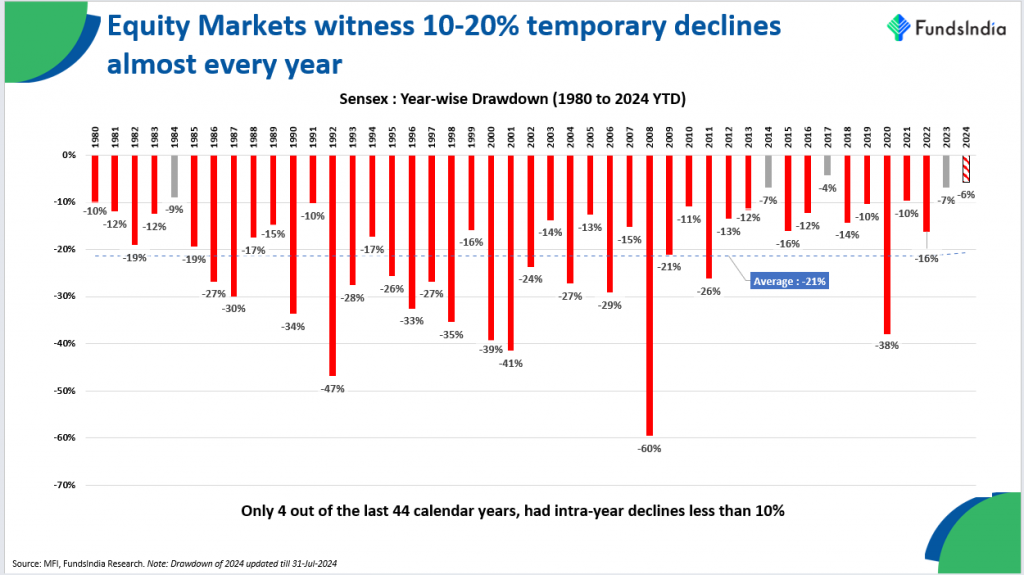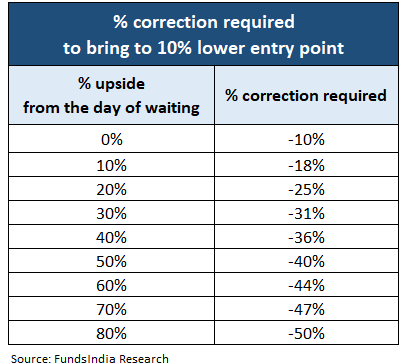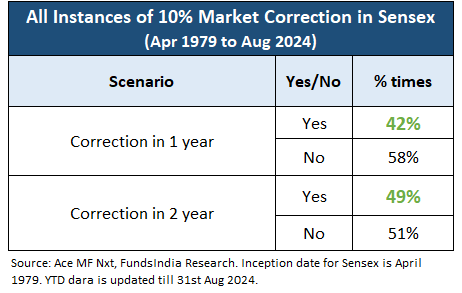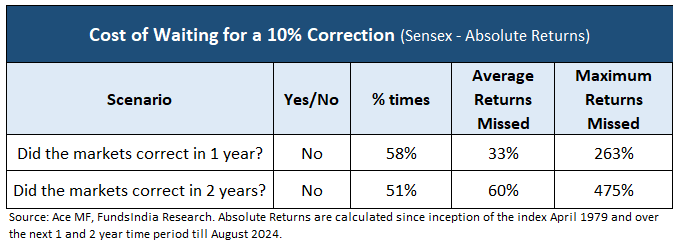Every time you will have cash to spend money on equities, a nagging thought inevitably comes up.
“Looks like markets may right from right here. Possibly I ought to wait and make investments after a ten% correction”
Intuitively, ready for a correction looks as if a prudent strategy.
However is that this tactic actually as efficient because it feels?
Let’s discover out…
For a greater understanding of market declines, let’s have a look at historical past. Within the beneath chart, you’ll be able to see the calendar year-wise drawdowns for Sensex during the last 44+ years.
Yearly noticed a brief market correction. EVERY SINGLE YEAR!
40 out of the 44 years had intra-year declines of greater than 10%!
Takeaway: 10-20% non permanent decline yearly is nearly a given!
So, if a 10-20% decline happens nearly yearly then does it not make sense to attend for this decline to speculate new cash?
Easy. Anticipate the correction of 10% and make investments the lump sum quantity when it happens.
Seems intuitive and logical.
Nonetheless there are 4 challenges {that a} ‘ready for a ten% correction’ technique throws up.
Problem 1: If markets proceed to go up, the correction wanted to re-enter should be a lot bigger than a ten% fall
In the event you’re ready to speculate after a ten% correction however the market continues to rally, the pullback required to re-enter will now not be simply 10%. You’ll want a bigger correction to speculate once more on the similar ranges.
For instance, in April 2024, when the Sensex was at 75,000, you determined to attend for a ten% correction (all the way down to 67,500) earlier than investing. Nonetheless, previously few months, the market has gone up ~13%, reaching 85,000. Now, you would wish a 20% correction to succeed in the identical 67,500 stage—excess of the unique 10% you deliberate for.
In brief, if the market doesn’t right as you count on and continues to rise, the drop required to get in at your goal value turns into considerably larger than 10%.
Problem 2: 45% of the occasions you by no means acquired a ten% decrease entry level!
Within the chart beneath, we’ve analyzed Sensex information from 1979 to the current (Aug-2024), protecting greater than 45 years. For every day on this interval, we look at the probabilities of the market dropping 10% from that day’s stage when you resolve to attend.
As an illustration, on March 24, 2020, the Sensex was at 26,674. A ten% correction would convey it all the way down to 24,000. We then test if, between March 25, 2020, and August 31, 2024, the Sensex ever fell beneath 24,000.
And right here comes the shocker!
45% of the time, the market by no means dropped by 10% from the extent the place you waited.
This might sound to contradict our earlier discovering that 10-20% declines occur nearly yearly.
However right here’s the nuance: whereas these corrections are frequent, they don’t at all times occur instantly. They’ll happen at any level sooner or later, typically from a lot larger ranges than the place you initially determined to attend.
The problem with holding off for a ten% correction is the uncertainty and the big odds of not getting the required 10% decrease ranges.
Since we don’t know when or at what stage the correction will begin, it’s troublesome to foretell when you’ll be within the 55% of the time when a ten% drop finally happens, or within the 45% of circumstances the place it by no means occurs.
Problem 3: The price of ready might be very excessive when you get it fallacious!
From what we’ve mentioned thus far, it’s clear that predicting the precise stage from which market corrections will happen is difficult. However what when you resolve to attend for that correction?
Traditionally, markets expertise a ten% correction about 55% of the time. So, when you won’t see a dip right now, it may occur subsequent month, or the month after. The query is: how lengthy must you wait?
Usually, buyers are prepared to attend 1-2 years for a correction earlier than they lose endurance and begin reconsidering their technique. Let’s see if ready for this era helps.
Utilizing the Sensex as a reference, we analyzed how typically a ten% correction occurred inside 1-2 years from any given day. For instance, on March 24, 2020, the Sensex stood at 26,674, so we checked whether or not it fell to 24,006 (a ten% drop) throughout the following 12 months (March 25, 2020 – March 24, 2021) and throughout the subsequent two years (March 25, 2020 – March 24, 2022).
Findings:
- ~50% of the time, the market gave you a ten% correction stage when you waited 1-2 years.
- In the event you consider ready past two years will increase your possibilities, it doesn’t. Since markets solely see a ten% correction 55% of the time in complete, there’s simply an extra 5% likelihood it’d occur after two years. However ready that lengthy hardly ever is smart.
Conclusion:
In the event you’re ready for a ten% correction, the technique works finest inside a 1-2 12 months window. Nonetheless, there’s a value to ready.
If the market doesn’t right inside 1-2 years and continues to rally, you miss out on these features. The missed returns compound over time, amplifying the price of staying out of the market.
The Value of Ready:
Within the desk beneath, we calculated the potential returns you miss when the market doesn’t expertise a ten% correction inside 1-2 years:
- On common, you miss out on 33% to 60% upside.
- In excessive circumstances, you could possibly miss a 260% to 475% upside, that means you’ll have missed the chance to multiply your preliminary funding by 3 to six occasions.
Key Takeaway:
Whereas ready for a ten% correction over a 1-2 12 months interval can generally work, the price of lacking out on important market rallies might be steep. In some circumstances, the returns foregone by ready may find yourself being far larger than what you’d achieve by catching that correction.
Problem 4 – Behaviorally it’s onerous to enter again at larger ranges
If you’re caught ready for a ten% correction that by no means comes and the market continues to rally, it turns into psychologically difficult to re-enter.
Two key elements make this troublesome:
- Accepting you had been fallacious: By selecting to speculate at larger ranges after ready for a correction that didn’t occur, you’re primarily admitting that your determination to carry off was incorrect. This admission is psychologically onerous to simply accept, and the discomfort of being “fallacious” can stop you from re-entering at larger ranges.
- Capturing a everlasting loss: If the market doesn’t right and as an alternative retains going up, you miss out on all of the potential features throughout that point. If you finally re-enter at larger ranges, you’ve successfully locked in these missed returns, which turns into a everlasting loss in your portfolio. This missed alternative is usually neglected when calculating general returns.
What must you do?
- The dilemma of investing now vs ready for a correction to speculate will come up many occasions all through your funding journey so it is very important settle for this as regular.
- However, ‘ready for a correction’ technique normally backfires due to these 4 challenges,
Problem 1 – If markets proceed going up over time, then the required correction to enter again additionally will increase and is rather more than only a 10% correction.
Problem 2 – 45% of the occasions you by no means acquired a ten% decrease entry level!
Problem 3 – The price of ready might be very excessive when you get it fallacious!
Problem 4 – Behaviorally, it’s onerous to enter again at larger ranges
- To keep away from this psychological urge to maintain ready for a market correction (learn as making an attempt to time the markets), it is very important have a predetermined rule primarily based framework to deploy lumpsum cash. You possibly can select to deploy lumpsum instantly or in case you are valuation acutely aware then you’ll be able to make investments a portion now and stagger the remaining utilizing a 3-6 months STP.
- At FundsIndia, we observe a Lumpsum Deployment Framework primarily based on FundsIndia Valuemeter (our in-house valuation indicator). By means of this framework a portion of the lumpsum is straight away invested and the remaining is staggered through 3-6 months STP. As a normal precept, we deploy quicker when valuations are decrease, and slower when valuations are costly.
Different articles you could like
Publish Views:
1,076







